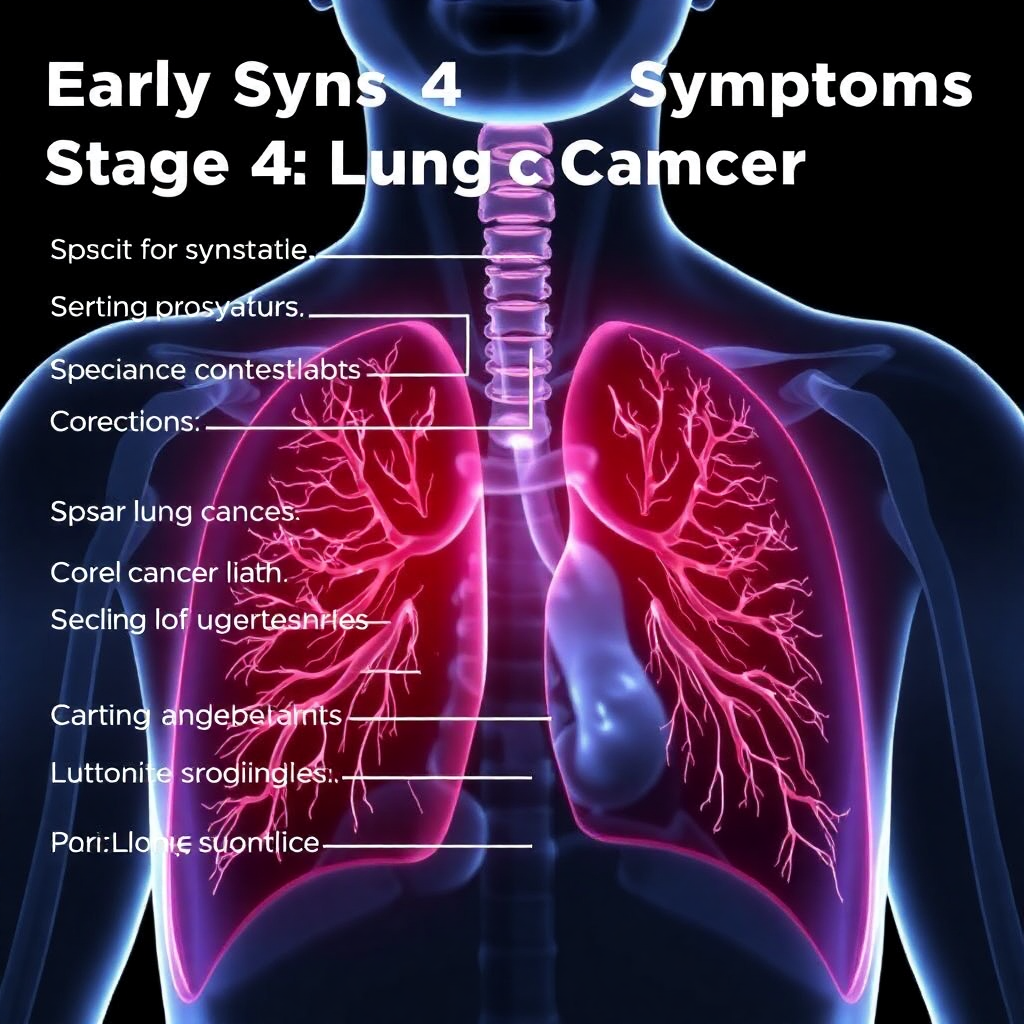Stage 4 lung cancer is a serious and advanced stage of the disease where cancer has spread beyond the lungs to other parts of the body. Identifying the signs and symptoms early can help manage the condition better. Here, we’ll dive deep into the symptoms, risk factors, and potential treatment options.
Understanding Stage 4 Lung Cancer
What is Stage 4 Lung Cancer?
Stage 4 lung cancer, also known as metastatic lung cancer, is when the disease has spread (metastasized) to distant organs like the brain, liver, or bones. At this stage, the cancer is considered advanced and difficult to cure.
How is Stage 4 Lung Cancer Diagnosed?
Doctors diagnose stage 4 lung cancer using imaging tests such as CT scans, MRIs, PET scans, and biopsies. These tests confirm the extent of cancer spread and guide treatment options.
General Symptoms of Stage 4 Lung Cancer
Persistent Cough
A chronic cough that doesn’t go away or worsens over time is one of the earliest signs of lung cancer.
Difficulty Breathing
Shortness of breath or wheezing often occurs due to blockages or fluid buildup around the lungs.
Chronic Fatigue
Feeling constantly tired and drained, even with sufficient rest, is a common complaint among patients.
Specific Symptoms Related to Cancer Spread
Symptoms of Metastasis to Bones
- Severe bone pain, often in the back or hips.
- Increased risk of fractures.
Symptoms of Metastasis to Brain
- Persistent headaches.
- Confusion or memory loss.
- Seizures or changes in vision.
Symptoms of Metastasis to Liver
- Jaundice (yellowing of skin and eyes).
- Abdominal pain or swelling.
Symptoms of Metastasis to Other Organs
- Skin changes or lumps under the skin.
- Pain in areas where cancer has spread.
Uncommon Symptoms of Stage 4 Lung Cancer
Horner’s Syndrome
A condition causing drooping eyelids, reduced sweating, and smaller pupils, typically due to nerve damage caused by tumors.
Superior Vena Cava Syndrome
This occurs when a tumor blocks blood flow in the superior vena cava, leading to swelling in the face, neck, and upper body.
Risk Factors and Early Detection Challenges
Who is Most at Risk?
- Smokers or former smokers.
- Individuals exposed to radon, asbestos, or secondhand smoke.
- Those with a family history of lung cancer.
Why is Early Detection Difficult?
Lung cancer symptoms often mimic other illnesses, leading to delayed diagnosis. Regular screenings for high-risk individuals can help catch the disease earlier.
Living with Stage 4 Lung Cancer
Managing Symptoms
- Palliative care focuses on improving comfort and quality of life.
- Medications to manage pain and other symptoms.
Treatment Options for Stage 4 Lung Cancer
- Targeted therapies and immunotherapy.
- Chemotherapy and radiation therapy.
- Clinical trials exploring innovative treatments.

Conclusion
While stage 4 lung cancer is a challenging diagnosis, understanding the symptoms and treatment options can empower patients and their families to make informed decisions. Living with the condition involves managing symptoms, staying positive, and seeking support from medical professionals and loved ones.
FAQs
1. What are the most common symptoms of stage 4 lung cancer?
The most common symptoms include persistent cough, shortness of breath, fatigue, and pain due to metastasis.
2. How is stage 4 lung cancer diagnosed?
Stage 4 lung cancer is diagnosed using imaging tests like CT scans, PET scans, and biopsies to confirm cancer spread.
3. Can stage 4 lung cancer be cured?
While a cure is rare, treatments can help control the disease, reduce symptoms, and improve quality of life.
4. What are the treatment options available for stage 4 lung cancer?
Treatment options include chemotherapy, targeted therapies, immunotherapy, radiation therapy, and participation in clinical trials.
5. How can patients improve their quality of life during treatment?
Focusing on symptom management, maintaining a healthy lifestyle, and seeking emotional support can improve quality of life during treatment.
| Category | Symptoms | Details |
|---|---|---|
| General Symptoms | Persistent cough | A chronic, worsening cough that doesn’t respond to typical treatments. |
| Difficulty breathing | Shortness of breath, wheezing, or feeling winded during routine activities. | |
| Chronic fatigue | Constant tiredness that persists even after adequate rest. | |
| Symptoms of Metastasis | Bones | Severe bone pain, commonly in the back or hips; increased risk of fractures. |
| Brain | Persistent headaches, memory loss, confusion, seizures, or vision changes. | |
| Liver | Jaundice (yellowing of skin and eyes), abdominal pain, or swelling. | |
| Other Organs | Skin changes or lumps, pain in areas affected by cancer spread. | |
| Uncommon Symptoms | Horner’s syndrome | Drooping eyelids, reduced sweating, smaller pupils due to nerve damage from tumors. |
| Superior vena cava syndrome | Swelling of the face, neck, and upper body caused by blocked blood flow. | |
| Risk Factors | Smoking or exposure to toxins | Includes radon, asbestos, and secondhand smoke. |
| Family history of lung cancer | Genetic predisposition may increase risk. | |
| Diagnosis | Imaging tests | CT scans, MRIs, and PET scans to locate and confirm metastasis. |
| Biopsies | Used to confirm cancer type and spread. | |
| Treatment Options | Targeted therapies, immunotherapy, chemotherapy, radiation therapy | Aim to control the disease, reduce symptoms, and improve quality of life. |
| Palliative care | Focuses on symptom management and comfort. |
